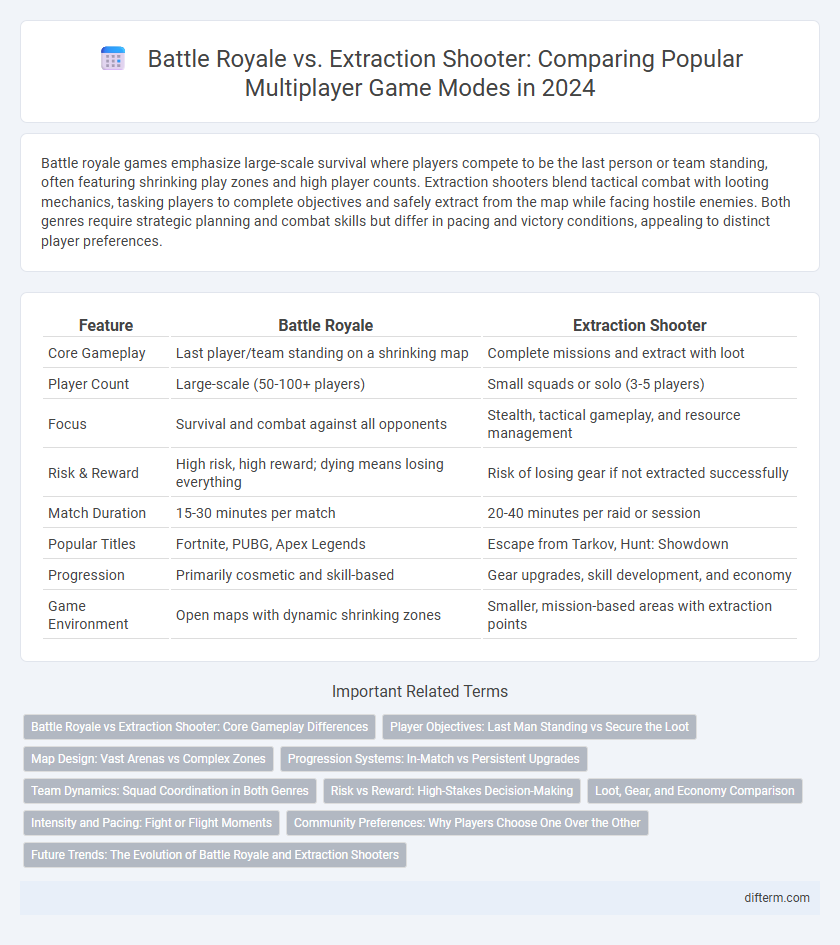Battle royale games emphasize large-scale survival where players compete to be the last person or team standing, often featuring shrinking play zones and high player counts. Extraction shooters blend tactical combat with looting mechanics, tasking players to complete objectives and safely extract from the map while facing hostile enemies. Both genres require strategic planning and combat skills but differ in pacing and victory conditions, appealing to distinct player preferences.
Table of Comparison
| Feature | Battle Royale | Extraction Shooter |
|---|---|---|
| Core Gameplay | Last player/team standing on a shrinking map | Complete missions and extract with loot |
| Player Count | Large-scale (50-100+ players) | Small squads or solo (3-5 players) |
| Focus | Survival and combat against all opponents | Stealth, tactical gameplay, and resource management |
| Risk & Reward | High risk, high reward; dying means losing everything | Risk of losing gear if not extracted successfully |
| Match Duration | 15-30 minutes per match | 20-40 minutes per raid or session |
| Popular Titles | Fortnite, PUBG, Apex Legends | Escape from Tarkov, Hunt: Showdown |
| Progression | Primarily cosmetic and skill-based | Gear upgrades, skill development, and economy |
| Game Environment | Open maps with dynamic shrinking zones | Smaller, mission-based areas with extraction points |
Battle Royale vs Extraction Shooter: Core Gameplay Differences
Battle Royale games emphasize large-scale survival where up to 100 players compete to be the last person or team standing, featuring a shrinking play zone that forces constant movement and frantic encounters. Extraction Shooters focus on smaller squads completing specific objectives within hostile environments, prioritizing tactical planning, resource management, and successful extraction rather than outright elimination. While Battle Royales highlight fast-paced, large-map combat with a high player count, Extraction Shooters deliver intense, methodical gameplay centered on strategic cooperation and risk-reward scenarios.
Player Objectives: Last Man Standing vs Secure the Loot
In battle royale games, the primary player objective is to be the last man standing by eliminating all opponents in a shrinking play area, emphasizing survival and combat strategy. Extraction shooters focus on securing valuable loot from hazardous zones and successfully extracting without dying, prioritizing tactical planning and resource management. The contrasting objectives highlight how battle royales drive aggressive player elimination, while extraction shooters reward careful looting and escape under pressure.
Map Design: Vast Arenas vs Complex Zones
Battle royale games feature vast arenas designed to accommodate large player counts, emphasizing open spaces, long sightlines, and multiple terrain types to encourage exploration and strategic positioning. Extraction shooters utilize complex zones with intricate layouts, including tight corridors, dense cover, and interactive elements that demand tactical movement and precise engagement. Map design in these genres directly impacts gameplay dynamics by shaping player interactions, risk management, and replayability.
Progression Systems: In-Match vs Persistent Upgrades
Battle royale games feature progression systems centered on in-match upgrades, where players start fresh each round and acquire weapons, gear, and abilities during the match, emphasizing adaptability and moment-to-moment decision making. Extraction shooters, in contrast, prioritize persistent upgrades that carry over between matches, allowing players to enhance their equipment, skills, and loadouts over time, fostering long-term strategic planning and character development. This fundamental difference influences gameplay dynamics, player investment, and the overall progression experience in these competitive multiplayer genres.
Team Dynamics: Squad Coordination in Both Genres
Battle royale and extraction shooter games both emphasize squad coordination but differ in strategic execution and team dynamics. In battle royale, teams prioritize survival through map control and adaptive tactics as the squad size often impacts the approach to engagement and resource management. Extraction shooters demand precise communication and role specialization for objective-based missions, requiring squads to balance offensive maneuvers with careful extraction timing to maximize success.
Risk vs Reward: High-Stakes Decision-Making
Battle royale games emphasize high-risk, high-reward scenarios where players compete against large groups, balancing aggressive engagement with survival strategies to secure victory. Extraction shooters prioritize tactical risk management, requiring players to extract valuable loot under threat, rewarding careful planning and quick decision-making. Both genres challenge gamers to evaluate immediate dangers against potential rewards, fostering intense moments where smart choices dictate success or failure.
Loot, Gear, and Economy Comparison
Battle royale games emphasize fast-paced looting with abundant gear drops scattered across large maps, creating a dynamic economy centered on securing resources quickly to survive. Extraction shooters prioritize strategic loadouts and carefully acquired loot that players must safely extract, fostering a high-risk, high-reward economy where every item retained impacts future gameplay. The economy in battle royale often resets each match, while extraction shooters build persistent economies around player progression and gear retention.
Intensity and Pacing: Fight or Flight Moments
Battle royale games deliver relentless intensity through large-scale confrontations and constant player encounters, creating high-stakes fight or flight moments that keep adrenaline levels soaring. Extraction shooters emphasize strategic pacing, balancing stealth and tactical withdrawals with sudden bursts of combat, fostering calculated decision-making amidst tension. Both genres challenge players' survival instincts but differ in how urgency and tempo shape the overall gameplay experience.
Community Preferences: Why Players Choose One Over the Other
Players often prefer battle royale games for their large-scale, fast-paced action and the thrill of being the last person standing among dozens or hundreds of competitors. Extraction shooters attract gamers seeking more tactical, team-based gameplay that emphasizes resource management and stealth over sheer firepower. Community discussions highlight the appeal of battle royales for immediate excitement, while extraction shooters are favored for strategic depth and immersive cooperative experiences.
Future Trends: The Evolution of Battle Royale and Extraction Shooters
Battle royale games are evolving with enhanced AI-driven environments and dynamic weather systems, increasing player immersion and strategic complexity. Extraction shooters are integrating persistent world mechanics and narrative-driven objectives, blending survival elements with tactical gameplay to attract hardcore audiences. Both genres are converging through cross-platform multiplayer support and hybrid game modes that emphasize player choice and evolving meta-strategies.
battle royale vs extraction shooter Infographic

 difterm.com
difterm.com